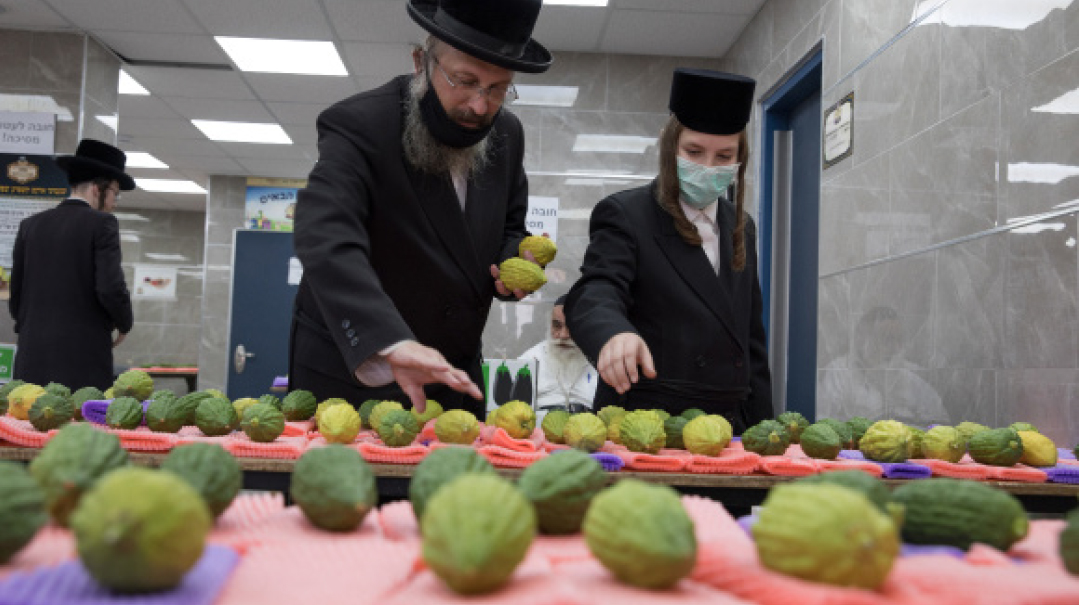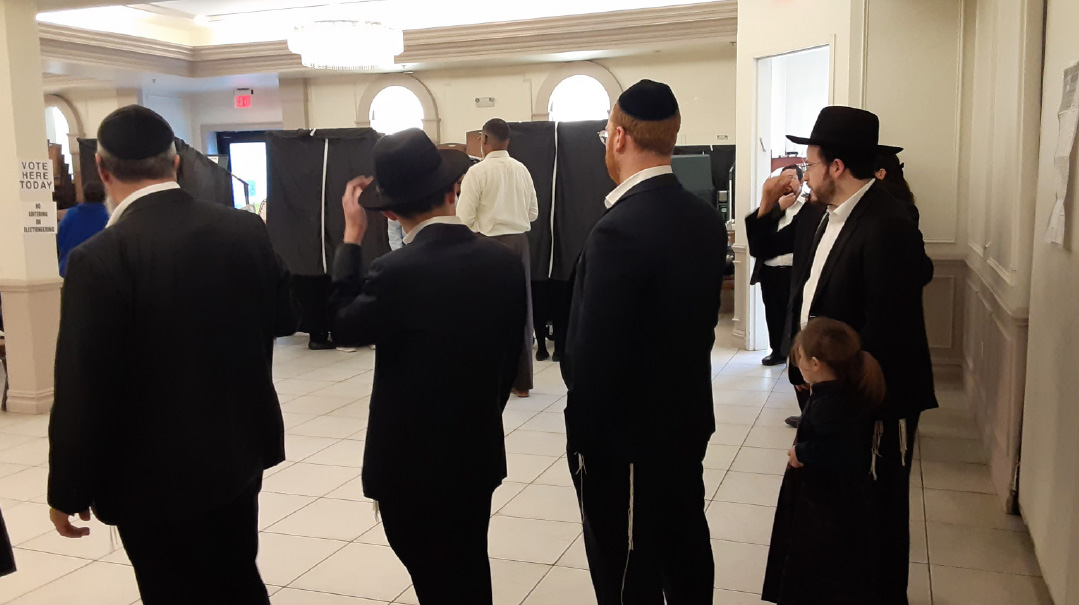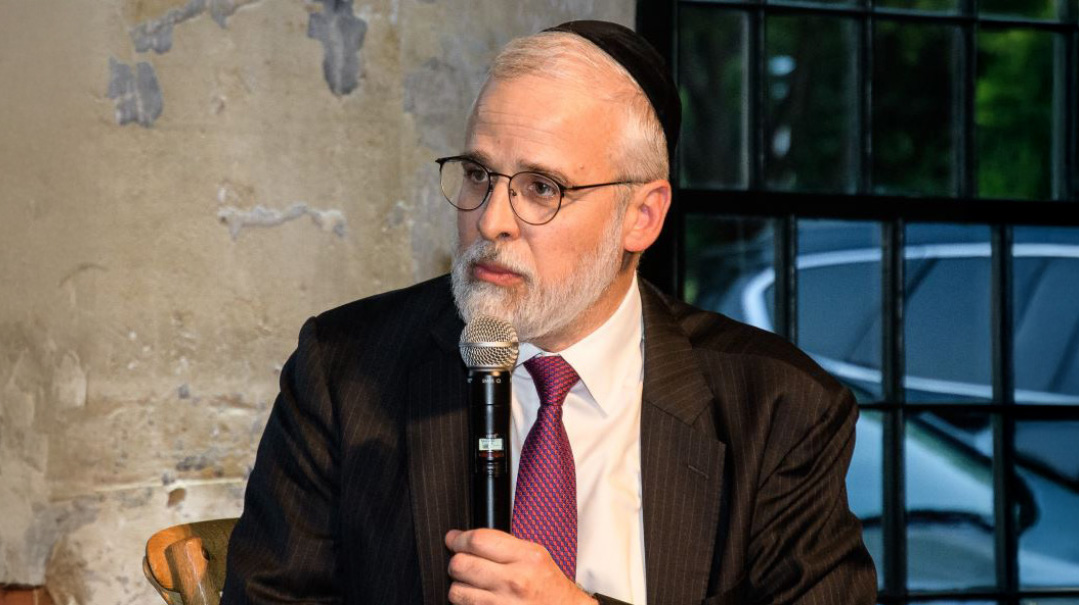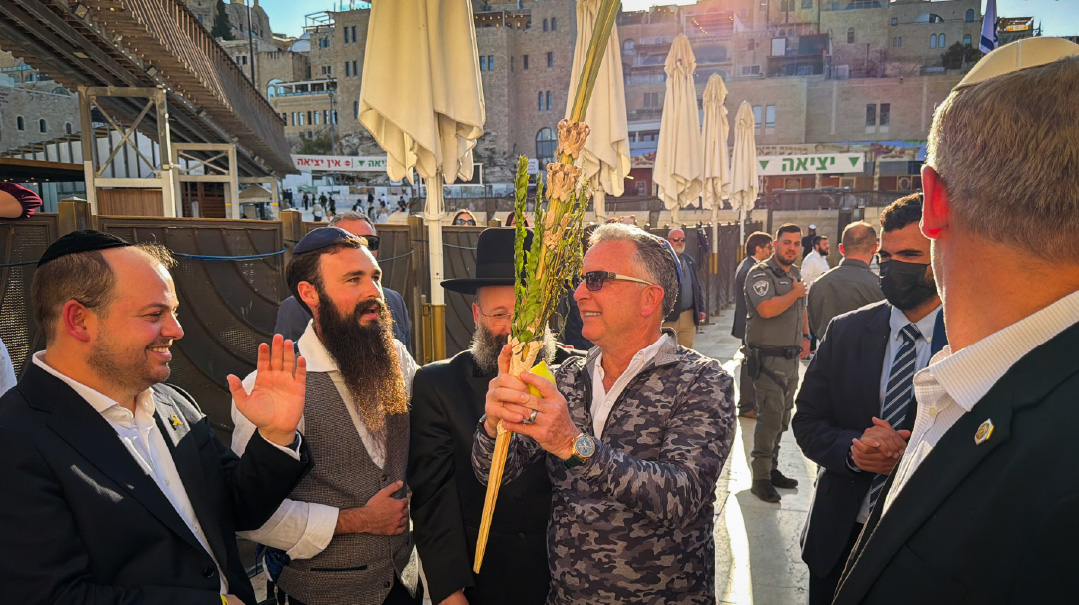From Heaven to Earth
| October 13, 2024Some ideas that reveal a single theme running throughout this very exalted season

Succos has endless layers of depth, unparalleled by any other Yom Tov. I would like to share some ideas that reveal a single theme running throughout this very exalted season. These insights will help to answer the following questions about Succos:
- How does Succos flow from Rosh Hashanah and Yom Kippur? How is it connected to these Yamim Tovim, both of which focus on the judgment of the world?
- Why is it that Hoshana Rabbah, the seventh day of Succos, is also designated as a Day of Judgment, mandating that we circle the bimah seven times carrying lulavim and esrogim?
- What is behind the special mitzvah of nisuch hamayim? Why is it performed only on Succos? And why is it celebrated with the immense joy of Simchas Beis Hashoeivah?
The insights we uncover will also help us answer more questions that revolve around Shemini Atzeres. These are:
- Chazal say that Hashem grants us another day of Yom Tov because “kashah Alai preidas’chem— your departure is difficult for Me.” But how does delaying our departure one more day help?
- The word atzeres means “stop” or “hold.” What is it that we’re trying to stop?
- What is the connection between Simchas Torah and Shemini Atzeres? What does celebrating the completion of the Torah have to do with Shemini Atzeres?
- In the Gemara, we find the Yom Tov of Shavuos referred to as “Atzeres” (see Pesachim 68b). Why would Chazal take a word used by the Torah to refer to Shemini Atzeres and apply it to Shavuos?
Divine Juggling
We can begin by exploring the Gemara in Succah (53b). There, the Gemara describes the incredible joy that infused the celebration of the Simchas Beis Hashoeivah.
The chachamim would dance with immense vigor under lights whose brilliance shone for miles. The narration takes note of Rabban Shimon ben Gamliel. He would take eight torches of fire and throw them into the air one by one, catching each as they fell, without allowing any torch to touch another. The Gemara then tells us that Rabban Shimon ben Gamliel would “prostrate himself and dig his two thumbs into the ground, and then kiss the floor.”
If a holy Tanna such as Rabban Shimon ben Gamliel was engaged in such actions, they must hold particular significance. I would like to suggest an explanation based upon the words of the Alshich in parshas Emor. There, in Vayikra 23:39, the Torah refers to Succos as “chag Hashem.” The Alshich questions this expression. For every other Yom Tov, the Torah uses the term “chag la’Hashem — a holiday to Hashem.” But for Succos, it says “chag Hashem,” which means “holiday of Hashem.” How do we understand this? How is Succos a “chag Hashem”?
The Alshich bases his answer on a teaching of the Midrash Tanchuma in parshas Naso. When Hashem created the world, says the Midrash, He desired that there should be a dirah batachtonim — a “dwelling place” in the lower worlds, just as there is in the upper worlds. When Hashem created the world, the Shechinah “dwelled” within it.
But when Adam sinned with the Eitz Hadaas, the Shechinah ascended to the “first rakiah (heaven).” When Kayin sinned, it went up to the second rakiah. The sins of the generation of Enosh made it rise to the third heaven, and the sins of the generation of the Mabul made it ascend to the fourth heaven. The generation of the Haflagah made it go up to the fifth heaven, and with the generation of Sedom, to the sixth heaven. The sins of Mitzrayim (in the days of Avraham) made it go up to the seventh heaven.
Then, says the Midrash, Avraham succeeded in bringing it down one level (from seven to six). When Yitzchak “stuck his neck out” at the Akeidah, it came down one more. Yaakov brought it down another, followed by his son, Levi, followed by Kehas, followed by Amram, followed by Moshe, who succeeded in bringing the Shechinah all the way down to the land — as the pasuk says, “Vayeired Hashem al Har Sinai.”
Before presenting his explanation, the Alshich points to a subtlety in the Midrash’s words. The Midrash says “Hashem wanted a dwelling place batachtonim — in the lower worlds.” The Midrash does not say that Hashem wanted a dwelling place “upon the land.”
This, the Alshich says, is because Hashem didn’t want to dwell upon the land, but rather within us. He points to the pasuk that commands us to build a Mishkan: “V’asu li Mikdash v’shachanti besocham — and you shall make for Me a Mikdash and I will dwell in them.” Shouldn’t it say “in it”? No, says the Alshich. Hashem wants to dwell in us, His Children, the Jewish People.
Hashem’s SImchah
The Alshich then goes back to answer his original question — why the Torah refers to Succos as “chag Hashem.”
When we were in Mitzrayim, says the Alshich, we had descended to the 49th level of tumah. When Hashem redeemed us, we were brought out of this intense impurity. Hashem then gave us the Torah, at which time the Shechinah returned to earth, as it says, “Vayeired Hashem al Har Sinai.”
But then the Jews sinned with the Eigel, and the Shechinah once again ascended upward. Hashem’s Name was desecrated — the sin of the Eigel gave justification to the claim of the angels prior to the world’s creation that man should not be created.
For 40 days, Klal Yisrael engaged in teshuvah, and Moshe Rabbeinu davened on their behalf. On Yom Kippur, Hashem granted them a kapparah and, with it, the Shechinah returned. It was then that we received the command to build the Mishkan — to serve as that dirah batachtonim in which the Shechinah could dwell.
To be able once again to dwell within His People gave HaKadosh Baruch Hu the greatest simchah.
This, says the Alshich, is why Succos is called chag Hashem. Succos follows Yom Kippur, when we receive our atonement for the sin of the Eigel — and all our sins in general. Four days later, Hashem dwells within us — as represented by our succah.
Thus, the true simchah of Succos is not to commemorate what happened to us; rather, it marks the tremendous joy that Hashem, kiveyachol, is experiencing.
Indeed, it is a chag Hashem.
Seven Heavens, Seven Days
With these insights, we can suggest a profound new perspective into the function of Succos.
We have learned that there are seven heavens through which the Shechinah can ascend. These seven heavens are represented by the seven days of Succos. In fact the Mahari Veil writes that the four minim of the lulav, esrog, hadas, and aravah actually total seven — three aravos, two hadasim, one lulav, one esrog. These, he says, correspond to the seven heavens. The Avudraham writes that we circle the bimah seven times in correlation with the seven heavens.
Once we recognize that each of the days of Succos relates to one of the seven heavens, we can gain a deeper understanding into the meaning of Hoshana Rabbah and why it is a Day of Atonement.
As we have learned, the Shechinah’s very first ascent came about as a result of Adam’s eating from the Eitz Hadaas. The Arizal teaches that within Adam were all the neshamos of Klal Yisrael. Thus, the sin of Adam Harishon had a profoundly damaging effect on all of us. Hoshana Rabbah — which, as the seventh day brings the Shechinah down to the very first heaven — is our chance to rectify that. This makes it an immensely powerful day of teshuvah; it is our chance to atone for the very first aveirah — the Cheit Eitz Hadaas.
The Eighth Day
And now we come to the very lofty and mysterious day of Shemini Atzeres. As mentioned above, the Shechinah’s ultimate desire is to dwell not within any of the seven heavens but rather down here, in the tachtonim — which is the eighth level. Shemini Atzeres is that dimension. It is the final destination of the Shechinah — the ultimate dirah batachtonim.
With this, we can answer our question on the Torah’s usage of the word atzeres, meaning “stop,” or “hold.” What are we trying to hold?
The answer is, we are holding the Shechinah. We are keeping it with us, not allowing it to ascend once again. The term atzeres is meant to express our desire that we commit no further sins and that the Shechinah remain forever with us.
This explains why Chazal refer to Shavuos as “Atzeres” — a term the Torah uses to refer to Shemini Atzeres. As we’ve learned, Moshe succeeded in bringing the Shechinah to earth specifically at Matan Torah — “Vayeired Hashem al Har Sinai.” It is in the merit of the Torah that the Shechinah remains on earth. Therefore, Shavuos can also be called Atzeres, connoting our desire for the Shechinah to be “held” and remain among us.
We asked what the purpose of one additional day of Yom Tov could be; if it is difficult for Hashem to part from us after seven days of Succos, then it will still be difficult after only one more day. We also asked how this final day of Yom Tov is connected to the celebration of the Torah.
Now, we can answer both. The seven days of Succos brought Hashem’s Shechinah down seven levels. But it was still not among us. Should we have ended Yom Tov then, Hashem would have had to “bid us farewell” — our connection would have never been cemented. But now, with an eighth day, we succeed in bringing the Shechinah all the way down — it is now among us. We immediately celebrate the Torah, for in its merit, the Shechinah wishes to remain here.
And through that, Hashem’s “pain” is eased. He no longer needs to say goodbye.
Crying Waters
We had questioned the meaning of nisuch hamayim and the Simchas Beis Hashoeivah. The concepts described above — that Succos revolves around the mission to bring the Shechinah down to This World — can serve as the basis for a very deep explanation.
Rabbeinu Bachaye in parshas Vayikra (2:13) quotes a midrash to the effect that, when Hashem divided the Upper Waters from the Lower Waters on the Second Day of Creation, the Lower Waters wept. They cried out, “Woe to us that we did not merit to ascend to be close to our Creator.” They broke through tehomos and sought to ascend — until Hashem ordered them to stop.
But because they acted for His honor, Hashem granted them three gifts. The first is that the Upper Waters would not be allowed to offer shirah until they received permission from the Lower Waters. The second is that every korban must be brought with salt — which comes from the ocean. The third is the mitzvah of nisuch hamayim — which is performed with water.
This midrash needs further explanation. What does it mean that the Lower Waters were anguished by their “distance from Hashem”? And how does the mitzvah of nisuch hamayim help?
We can answer that being “distant from Hashem” means being tethered to This World, from which the Shechinah ascends in times of sin. The Lower Waters wished to dwell above, near their Creator, and have no fear of sin.
Hashem comforts them with the mitzvah of nisuch hamayim on Succos. Because on Succos, we merit to bring down the Shechinah to this world. Thus, the water can enjoy the closeness that it wishes for. We perform the mitzvah of nisuch hamayim with the greatest of joy, as it symbolizes the answer to the waters’ cries and the dwelling of the Shechinah among us.
Flame Before a Torch
And now we can explain the depth of Rabban Shimon ben Gamliel’s juggling of torches. There is a concept introduced by the Ramban (Bereishis 12:6) called “po’el dimyon.” This means that, in order to effect a certain reality in Shamayim, we must perform an action Down Here that elicits the cosmic response we seek.
The Gemara in Pesachim (8a) teaches that tzaddikim are compared to a “ner lifnei ha’avukah — a flame before a torch.” Tzaddikim have the ability to bring the Shechinah down from the seven heavens to earth.
R-abban Shimon ben Gamliel juggled eight torches. He threw up all eight of them — an allusion to the Shechinah’s ascent from earth to the seventh heaven — and then allowed each of them to fall, representing the descent to earth.
Then he prostrated himself and “dug his two thumbs into the ground.” This represents the Shechinah’s descent to earth, after which it shall remain firmly planted.
Then he “bowed and kissed the floor.” Because with the Shechinah Down Here, the very floor is elevated with its holiness.
On Succos, we embark on the journey of bringing down the Shechinah from the seventh heaven to Earth. On Shemini Atzeres, the Shechinah is “ours” to maintain. And this is in the merit of the Torah.
Let us all strive to strengthen ourselves in Torah and thus live with a constant connection to the Shechinah.
Rav Pinchas Friedman is the rosh yeshivah of Yeshivas Mevakshei Hashem in Jerusalem, and the author of several seforim, including Shvilei Pinchas on Chumash and Moadim, and Pri Hador, a commentary on Pri Megadim hilchos basar b'chalav.
(Originally featured in Mishpacha, Issue 1033)
Oops! We could not locate your form.







